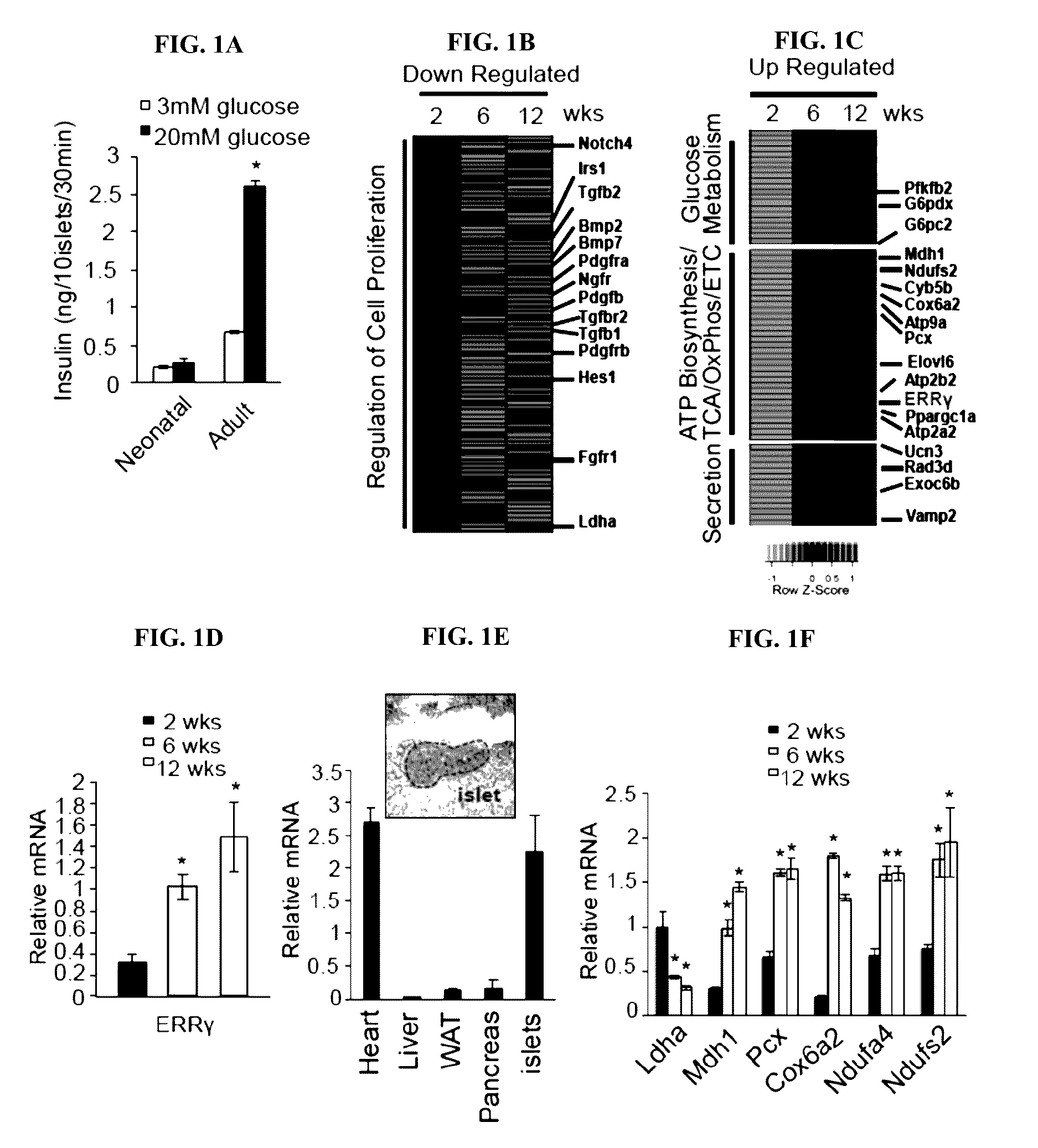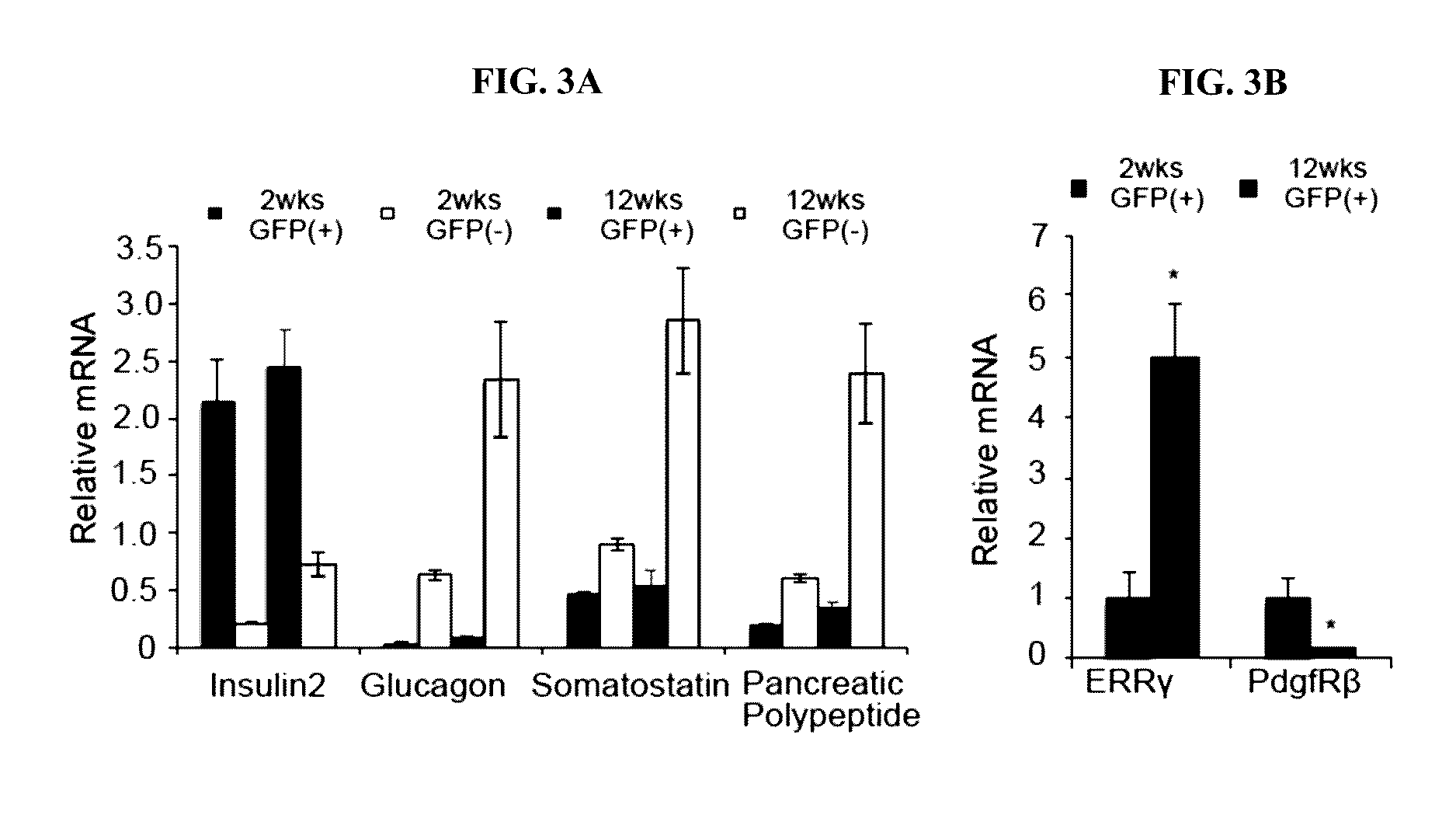Compositions and methods for treating type 1 and type 2 diabetes and related disorders
a type 1 and type 2 diabetes and related disorder technology, applied in drug compositions, peptides, metabolic disorders, etc., can solve the problems of increasing the risk of diabetes, so as to prevent the occurrence or recurrence of disease, prevent metastases, and reduce the risk of diabetes. direct or indirect pathological consequences
- Summary
- Abstract
- Description
- Claims
- Application Information
AI Technical Summary
Benefits of technology
Problems solved by technology
Method used
Image
Examples
example 1
Postnatal Islets Acquired Oxidative Features
[0156]Beta cells are known to functionally mature postnatally, including acquiring the ability to robustly secrete insulin in response to glucose. Consistent with an immature phenotype, islets isolated from 2 week-old neonatal mice were unable to secrete insulin in response to a glucose challenge (FIG. 1A). To identify important pathways required for glucose-stimulated insulin secretion (GSIS), the transcriptomes of isolated islets during postnatal maturation were compared. Consistent with beta cell terminal differentiation being essentially completed postnatally, and the fact that adult cells were formed by self-duplication rather than stem cell differentiation ENREF 13 (Dor et al., 2004, Adult pancreatic beta-cells are formed by self-duplication rather than stem-cell differentiation. Nature 429, 41-46), the expression of genes known to regulate pancreatic endocrine development in rodents and humans were largely unchanged postnatally (FIG...
example 2
ERRgamma was Required for Glucose-Stimulated Insulin Secretion
[0158]To investigate the role of ERRgamma in the functional maturation of pancreatic beta cells, beta cell-specific ERRgamma knockout (betaERRgammaKO) mice were generated by crossing ERRgammalox / lox mice with rat insulin 2 promoter (RIP)-Cre mice. ERRgammaKO mice were born at the expected Mendelian frequency and exhibited normal body weights and life expectancies (FIG. 4A and FIG. 4B). The RIP-Cre recombinase selectively decreased ERRgamma expression by 80% in ERRgammaKO compared to wild-type ERRgammalox / lox islets without significantly affecting hypothalamic ERRgamma expression (FIG. 4A and FIG. 4B), in agreement with recent similar reports (Tang et al., 2003, Cell metabolism 18, 883-895). Monitoring ad lib fed blood glucose levels of ERRgammaKO mice revealed a transient increase in female mice that was resolved by 8 weeks of age (FIG. 4C and FIG. 4D). However, at 8 weeks of age, both male and female ERR KO mice were glu...
example 3
ERRgamma was Required for Beta Cell Metabolic Maturation
[0162]As mitochondrial function and morphology are tightly correlated (Tang et al., 2013, Cell metabolism 18, 883-895; Narkar et al., Cell metabolism 13, 283-293), it was investigated whether structural changes were detectable in ERR KO beta cell mitochondria. Electron microscopy revealed that the insulin and proinsulin granules, and the overall mitochondrial number were not affected by ERRgamma deletion (FIGS. 10A and 10B). However, mitochondria swelling with disrupted cristae structure was seen in the ERRgamma-deficient beta cells, with significant increases in mitochondrial length, width, and volume, hallmarks of functionally defective mitochondria (FIGS. 10A-10C).
[0163]To understand the molecular role of ERRgamma in beta cell function, the transcriptional consequences of ERRgamma deletion were determined. In the developmentally-deleted ERRgammaKO islets, RNA-Seq revealed that the expression of 4189 genes was altered, with a...
PUM
| Property | Measurement | Unit |
|---|---|---|
| temperature | aaaaa | aaaaa |
| pH | aaaaa | aaaaa |
| β- | aaaaa | aaaaa |
Abstract
Description
Claims
Application Information
 Login to View More
Login to View More - R&D
- Intellectual Property
- Life Sciences
- Materials
- Tech Scout
- Unparalleled Data Quality
- Higher Quality Content
- 60% Fewer Hallucinations
Browse by: Latest US Patents, China's latest patents, Technical Efficacy Thesaurus, Application Domain, Technology Topic, Popular Technical Reports.
© 2025 PatSnap. All rights reserved.Legal|Privacy policy|Modern Slavery Act Transparency Statement|Sitemap|About US| Contact US: help@patsnap.com



